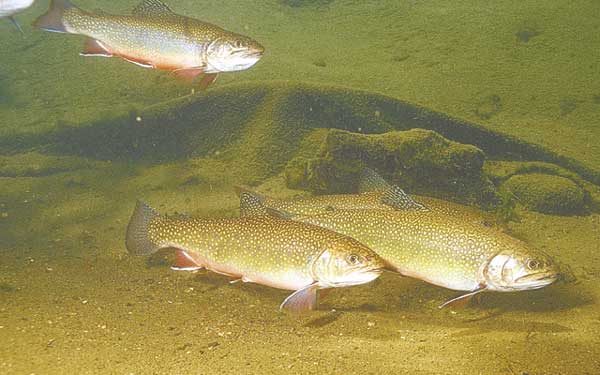
Western North Carolina has more than a dozen lakes that have fair-to-excellent populations of trout. Some of these lakes, especially smaller ones, are classified as hatchery-supported waters and are stocked with catchable-size trout from early March through June. In the larger reservoirs, stocked and wild trout enter the lake via tributaries.
Anglers who limit their trout fishing to streams will miss some challenging fishing and some big trout. With more food resources and habitat at their disposal, lake trout tend to grow larger more quickly than their stream counterparts. Four- and 5-pound trout are not uncommon.
Although trout usually are widely dispersed in lakes, the best places to find them are at the mouths of streams and rivers and a main lake channels where water is cooler. In the hot summer months, trout tend to congregate in deeper areas of lakes, especially around dams.
Most lake trout are rainbows, which take on a silvery sheen after a year or two in their new habitat and often are mistaken for steelhead trout. The N.C. Wildlife Resources Commission stocked steelhead from Michigan and upstate New York at some area lakes in the 1970s. The steelhead apparently never acclimated to their new surroundings because none showed up in later creel surveys.
David Yow, WRC fishery research coordinator, said it’s possible the steelhead crossbred with rainbow trout.
“They’re essentially the same species,” he said.
While the majority of lake trout are rainbows, Yow said high mountain lakes also have brown trout and brook trout. In the larger lakes, rainbow and brown trout can be a mix of wild and stocked trout, but the brook trout most always are stockers.
The most common, and most effective, technique for catching lake trout is trolling, using down-riggers or lead-core line. Anglers also tie up around dams and jig the deep water using nightcrawlers.
Randall Veal, owner of Santeetlah Marina at Santeetlah Lake in Graham County, said a sure-fire technique for catching trout is to troll the main lake channel at about 2 ½ mph with a No. 44 Sutton Spoon in about 25 feet of water. After dark, the best place to catch fish is at the left side of the dam, jigging with nightcrawlers at depths of 25 to 30 feet and using lights.
“We have good populations of lake trout, averaging 15 to 20 inches with some running up to 29 inches,” he said.
At Lake Lure in Rutherford County, former fishing guide David Pye trolls with lead-core line when he fishes for trout.
“I prefer lead-core line over down-riggers because I believe the ball on a down-rigger spooks trout,” Pye said. “Lead-core is simple and easy to use, and you get an instant hookset.”
The main point to remember when trolling for trout, Pye said, is “don’t jerk the line when you get a hit, just start reeling.”
Pye uses a No. 44 and No. 61 Sutton Spoon or a Little Cleo when he trolls the main lake channel.
Lake Lure, a town-owned stream, isn’t a part of the designated mountain trout waters system. However, the lake generously is stocked with trout in the spring, and some trout enter the lake from the Rocky Broad River. Lake Lure has a minimum-size limit of 15 inches for trout. Public lakes don’t have a size limit on trout.
“I’ve caught some really nice trout (at Fontana Lake),” said .Jim Mathis of Almond Boat and RV Park,
When Mathis fishes a the mouths of noted trout streams such as Chambers, Hazel, Forney, and Panther creeks, he uses spinnerbaits. For deep-water trolling, he prefers spoons and Rapalas. For night fishing near the dam, he said the fishers who have the most success “flutter” nightcrawlers or jigs at depths of 60 to 90 feet.
For surface fishing, small spinners such as Mepps Aglia, Rooster Tail, and Blue Fox are especially effective around feeder streams, as are small silver crankbaits.
Lakes with the best natural populations of trout are Fontana (Graham and Swain counties), Santeetlah (Graham County), Glenville/Thorpe (Jackson County), Bear Creek (Jackson County), Cedar Cliff (Jackson County), and Nantahala (Clay and Macon counties) lakes. Hiwassee in Cherokee County, Chatuge in Clay County, and Apalachia in Cherokee County have fair populations of trout.
Stocked lakes are Cheoah in Graham and Swain counties, Tanasee Creek, Bear Creek and Wolf Creek in Jackson County, Calderwood Lake in Graham County, along with a handful of smaller lakes: Queens Creek in Macon County, Cliffside Lake in Macon County, Balsam in Jackson County, Powhatan in Buncombe County, and Max Patch Pond in Madison County.
These lakes are designated as mountain trout waters. Fishers must have a comprehensive fishing license (includes trout stamp and game lands permit) to fish in these lakes. A basic state fishing license is all that’s required in the other lakes. Creel limit is seven trout at all lakes.
The tailrace waters of Cheoah Lake below Fontana Dam regularly produce trophy-size trout.
Calderwood Lake, managed by Tennessee and North Carolina, also yields big trout. Both states’ wildlife agencies stock Calderwood. Tennessee puts about 7,000 trout in the lake each year, and North Carolina adds another 1,400, all brook trout.
Larger lakes have marinas and/or public access boat ramps. Tanasee Creek, Balsam, Queens Creek, Powhatan, and Max Patch don’t have ramps.
Powhatan, Balsam, and Max Patch have fishing piers or fishing platforms. Motorized boats aren’t permitted on the small lakes.




Be the first to comment